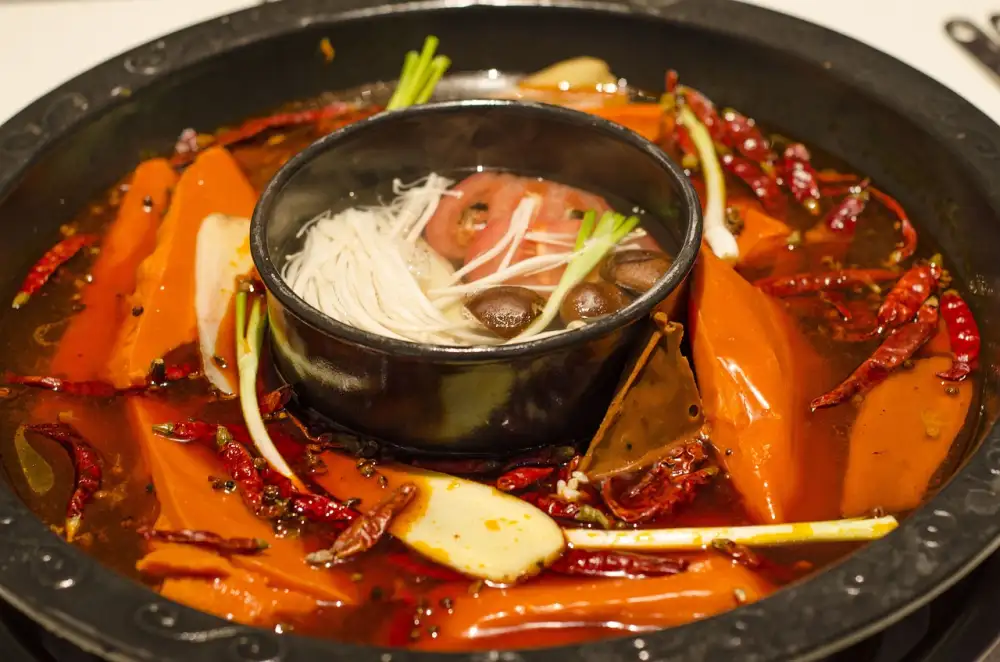Savor the Simmer: Exploring the Delights of Hotpot Dining

Hotpot, a traditional Chinese cooking method, brings people together around a simmering pot of soup stock. This communal dining experience is not just about the food but also about the shared enjoyment of cooking and eating together. The hotpot tradition dates back centuries in China and has evolved into a beloved culinary practice that celebrates freshness, flavor, and togetherness. Join us on a journey to explore the delights of hotpot dining!
History and Origins:
Hotpot, known as "huǒguō" in Chinese, has a rich culinary history dating back over a thousand years. Originating in Mongolia during the Jin Dynasty (1115-1234), hotpot quickly spread throughout China, becoming a beloved tradition. Each region in China has put its own unique spin on hotpot, with Sichuan's fiery and numbing broth, Canton's light and clear soup base, and Beijing's lamb-centric variations standing out. This communal dining experience not only satisfies the palate but also reflects the diverse cultural heritage of Chinese cuisine.
Ingredients and Broths:
In hotpot dining, a variety of ingredients come together to create a flavorful and interactive meal experience. From thinly sliced meats like beef, lamb, and pork to fresh seafood such as shrimp, fish balls, and squid, the choices are diverse. Vegetables like leafy greens, mushrooms, and tofu add a healthy touch. Noodles or rice cakes can be added for a hearty finish. Broth bases play a crucial role in hotpot, with options ranging from the fiery heat of Sichuan's spicy broth to the lightness of clear chicken broth or the earthiness of mushroom broth. Each element contributes to the rich tapestry of flavors that make hotpot a beloved culinary tradition.
Cooking Process:
To cook hotpot at the dining table, start by selecting your desired broth base. Once the broth is simmering, add in ingredients like thinly sliced meats, fresh seafood, leafy greens, and mushrooms. Allow these to cook in the bubbling broth until tender. Use a strainer or ladle to retrieve items from the pot as they finish cooking. To enhance flavors, dip cooked ingredients into various sauces like sesame paste or chili oil before enjoying. Remember to adjust the heat level of the pot to control cooking times and maintain a steady simmer for optimal results.
Health Benefits:
Hotpot offers a plethora of nutritional advantages that contribute to its reputation as a wholesome dining choice. The emphasis on fresh ingredients like lean meats, seafood, and an array of vegetables ensures a high intake of vitamins, minerals, and antioxidants. Additionally, the minimal use of oil in the cooking process makes hotpot a healthier alternative to many other cooking methods. The communal nature of hotpot dining promotes social bonding and mindfulness in eating, encouraging moderation and shared enjoyment of a balanced meal.
Popular Hotpot Varieties:
Hotpot enthusiasts can delight in a variety of regional styles beyond the traditional Chinese hotpot. Mongolian hotpot, known for its hearty lamb-based broth and array of fresh vegetables, offers a unique dining experience. Taiwanese hotpot features a flavorful and slightly sweet broth, often paired with thinly sliced meats and handmade meatballs. Japanese shabu-shabu focuses on thinly sliced meats like wagyu beef dipped in a light kombu seaweed broth. Each style showcases distinct ingredients and preparation methods, adding to the rich tapestry of hotpot culture worldwide.
Hotpot Culture:
Hotpot holds a special place in Chinese culture, symbolizing togetherness and warmth. It is not just a meal but an experience that fosters connection and camaraderie. In Chinese society, hotpot gatherings are cherished for bringing people closer, whether it's celebrating milestones, strengthening family bonds, or simply enjoying time with friends. The interactive nature of hotpot dining encourages shared experiences and lively conversations, making it a beloved tradition that transcends generations. The act of cooking and sharing food around a communal pot embodies the essence of unity and harmony in Chinese social customs.
In conclusion, hotpot stands as a cherished culinary tradition that continues to captivate food enthusiasts worldwide. Its ability to bring people together around a steaming pot of flavorful broth reflects the essence of communal dining and shared experiences. The versatility of hotpot allows for endless creativity in ingredient selection and broth combinations, making it a truly customizable dining experience for all preferences. As you embark on your own hotpot journey, remember to savor each moment and embrace the warmth of good food and great company. So gather your friends and family, immerse yourself in the rich flavors of hotpot, and create unforgettable memories around the dining table. Cheers to the joy of hotpot dining!
Published: 24. 04. 2024
Category: Food



